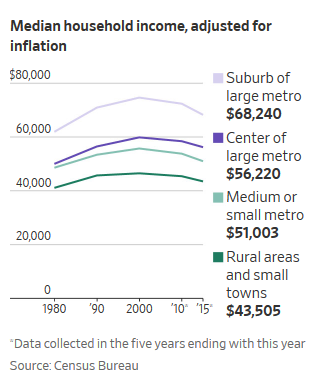The Daily Escape:

Frozen Waterfall in Adirondacks – 2018 photo by I_am_Bob
A December 29th WSJ article charted the growing gulf in health and well-being between urban and rural America:
About 1 in 7 Americans live in rural parts of the country—1,800 counties that sit outside any metropolitan area. A generation ago, most of these places had working economies, a strong social fabric and a way of life that drew a steady stream of urban migrants. Today, many are in crisis. Populations are aging, more working-age adults collect disability, and trends in teen pregnancy and divorce are diverging for the worse from metro areas. Deaths by suicide and in maternity are on the rise. Bank lending and business startups are falling behind
These rural counties now rank the worst among the four major US population groupings (the others are big cities, suburbs and medium or small metro areas). In November 2016, these rural districts voted overwhelmingly for Donald Trump, based in part on his pledge to revive these forgotten towns by scaling back trade agreements, ending illegal immigration and encouraging manufacturing companies to hire more American workers. He also promised a $1 trillion infrastructure bill that would help create jobs, but, like the other promises, it may never become a reality.
Back in the late 1970s – 1980s, the nation’s basket cases were its urban areas. A toxic stew of crime, drugs and suburban flight made large cities the slowest-growing and most troubled places. But violent crime in the cities (despite claims by a well-known, Very Stable Genius) have declined to the point that there no longer is any “safety premium” from living in rural America.
Today, by most key measures of socioeconomic well-being, the largest cities are as safe, and are much wealthier than our rural and small metro areas.
For decades, America’s small towns barely grew. Rural families had just enough children to offset losses from those who left, and those who died. The decline in median household income is reflective of that trend. The graph below is based on census data. It shows that household incomes (adjusted for inflation) peaked around the end of the Clinton administration and continue to decline, and not just in rural areas:

These rural parts of America are caught in the vise of limited economic opportunity coupled with terrible health outcomes.
About half of these counties would be called “failed states” if they were countries, meaning that the infrastructure of skilled labor, healthcare, privately owned commerce and aggregate demand for goods and services are not enough to make them economically viable.
Education gaps also have long-term consequences. More jobs, particularly full-time jobs with benefits, require a bachelor’s or advanced degree. Without a larger share of college graduates, small towns have little hope of closing the income gap.
Solution? We need to create a way to finance those who might be willing to move to economically viable regions. Many people today can make a living just by being connected by phone and internet.
If they were to choose to reside in a rural town, they would become an economic generator, helping these communities that truly need the help. If the nascent infrastructure proposals by the GOP include building up our nation’s broadband system, it could help to support a dispersed work group more easily.
Every demographic region except rural America has improved on most quality of life measurements. In those aspects where things have gotten worse, such as diabetes and suicide rates, rural America has the highest rates.
Time for America to wake up: We need a Marshall Plan right here at home to renovate our small towns and rural areas. To help you wake up, listen and watch the Philadelphia sextet The War on Drugs perform “Holding On” from their 2017 album “A Deeper Understanding”. Watch the atmospheric video:
Takeaway Lyric:
I went down a crooked highway
I went all outside the line
I’ve been rejected, now the light has turned and I’m out of time
Those who read the Wrongologist in email can view the video here.

i lived for 3 years in Dayton Ohio, but worked for a time in Xenia and when I drove my employees home (these were kids) they lived in farm county. Xenia itself was a typical agricultural country town.
2 thoughts about rural America. The first is that Ag policy (dating back to Earl Butz) was to make farms bigger but simpler, so farm aid discouraged the old farm garden, and the raising of chickens for eggs, and cows for milk. These tasks kept lots of small farm jobs in local farm economies, so you needed to collect small supplies of milk and eggs, and needed to collect vegetables and sell them. Eliminating these eliminate a host of small but skilled jobs (for example, the farm hand who kept up the fences and chicken coops.
Then we have Walmartization. In a small farm town, you once had hardware stores that sold bikes at Xmas, and so forth. So the hardware store employed a man who was skillful enough to assemble a bicycle or repair a bicycle tire. These stores disappeared as Walmart entered. The downtowns collapsed. Also the well to do folks who lived in town (example for me, is Fairborn Ohio) moved to a larger new house built in the township outside of town that was opened up to development by the interstate (i am thinking of I 75 in Ohio.
Even worse is a separate matter of furniture manufacturing and leather goods (staples across the small towns from the Carolinas to Maine) being displaced by overseas goods. The women who once did the upholstery (I have seen them) lost their jobs.